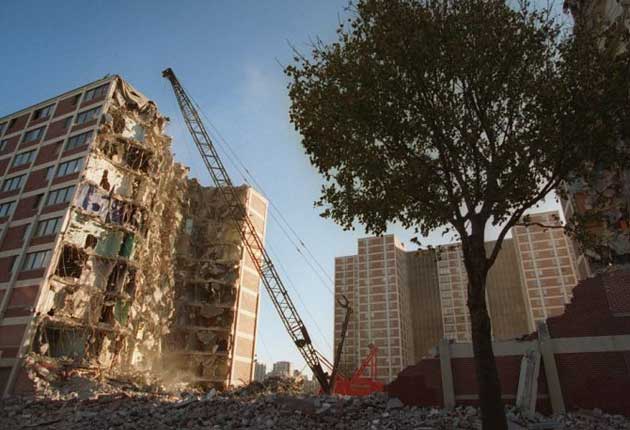Chicago takes wrecking ball to its final tower of violence

The racket of five decades – clamouring babies, yelling spouses and even the occasional crack of gunfire – are suddenly gone from Cabrini-Green, a high-rise apartment project near downtown Chicago that became a symbol of public housing gone awry. All will remain quiet now until the wrecker's ball strikes.
Not that there is too much left of it, anyway. For several years, Chicago has been tearing down the unprepossessing red and white towers that stood a stone's throw from the city's wealthy heart and yet, spread over 72 acres, was the site of some of the most glaring poverty and shocking violence.
Late last week, the last few remaining residents of the only tower still standing got the news they had been expecting. Alternative housing had been found for them and finally they had to leave. In fact, the order was given for them to vacate by nightfall on Tuesday. The tower is to be demolished in January.
"I don't think anyone is going to mark that as a holiday," noted Bradford Hunt, a professor of history and urban studies at Roosevelt University who has a written book on the topic, Blueprint for Disaster: The Unravelling of Chicago Public Housing. "There are just so many painful memories associated with the place. Some awful events that happened there are seared in the minds of Chicagoans."
Once home to 13,000 people, Cabrini-Green was an experiment in giving working-class families affordable shelter. But over time it became one the country's most cited examples of what not to do in urban planning. "It is still considered to have been a massive public policy failure," says Professor Hunt.
After the towers went up in the late fifties to supplement low-rise housing that already existed there, versions of them sprouted in cities across America. Indeed, entirely similar public housing projects remain in other parts of Chicago, but none acquired the same degree of infamy.
If the towers became virtual prisons, it may be partly because of the steel mesh sheath the city encased them in when they decided that the high outdoor galleries were too dangerous to be left open. While residents felt trapped inside, the police had difficulty seeing in and crime soared.
It's been 10 years since the city vowed to topple the towers. The death knell for them perhaps sounded first in 1992 when seven-year-old Dantrell Davis was killed by a stray bullet while walking to school with his mother, or in 1999, when an 11-year-old girl was found raped and poisoned in a stairwell.
In truth, the rot had set in earlier. In 1970 two police officers were killed by high-power rifle fired from a high floor. After gang warfare in and among the towers killed 11 of its residents over a period of months in 1979, the then Mayor of Chicago, Jane Byrne, moved into one of the apartments to demonstrate her faith in the efforts to clean the towers up.
It was a well-received gesture. But, by then, the working class families who mostly populated Cabrini-Green when it was first built had fled, their place was taken by Chicago's poorest who were dependent on welfare and on making money any way they could. It was the explosion of the city's drug epidemic that, according to Professor Hunt, finally "crushed" the project and it never recovered.
As preparations for the demolition of the final tower begin, scholars will note the circularity of Cabrini-Green finally being torn from the city by the current mayor, Richard M. Daley, who leaves office in February. He made it one of his top priorities in his last term in office. But he will hardly be unaware many still recall that it was his father, Mayor Richard J. Daley, who oversaw the building of the towers in the first place.
Join our commenting forum
Join thought-provoking conversations, follow other Independent readers and see their replies
0Comments